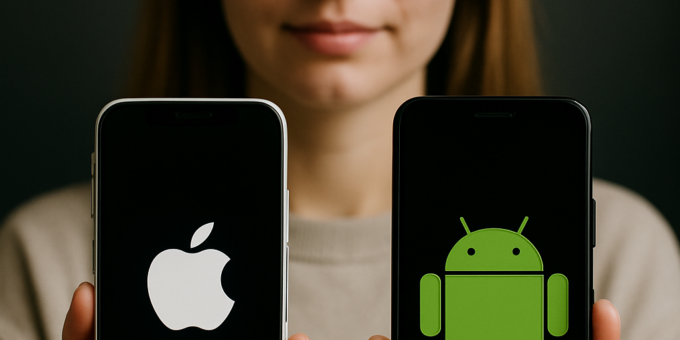
Smartphones have become the cornerstone of our digital lives. And the two tech titans—Apple and Android—stand at the forefront of this revolution. With each launch, they push the boundaries of what’s possible. But when it comes to actual tech advancements, who wears the crown?
Apple vs Android
The debate over Apple vs Android is as old as the smartphone itself. Apple, with its vertically integrated approach, ensures seamless synergy between hardware and software. Android, on the other hand, powered by Google, champions openness, customization, and innovation through a diverse range of manufacturers.
Apple offers a tightly controlled, consistent user experience across its devices. Every iPhone is a testament to the brand’s obsession with detail. Conversely, Android’s strength lies in its diversity—Samsung, Google Pixel, OnePlus, and others add unique flavors to the platform.
Interestingly, the core difference also lies in philosophy: Apple innovates by refining, while Android often dares to disrupt.
Operating Systems
When you compare iOS to Android, you immediately notice their contrasting update strategies. Apple supports devices for 5–6 years, making older iPhones feel surprisingly fresh. In contrast, Android updates are fragmented—some phones receive updates quickly, others not at all.
However, Android 14 has made strides in reducing latency, improving UI fluidity, and enhancing privacy settings. Yet, iOS 17 still leads with features like StandBy mode and enhanced AirDrop capabilities, which demonstrate Apple’s continuous polish.
Processor Power
Apple’s A17 Pro chip, built on a 3nm process, is a marvel. It leads in single-core and multi-core performance, particularly in gaming and machine learning tasks. Apple’s custom GPU architecture also allows console-level graphics on mobile.
Android devices, primarily powered by Snapdragon 8 Gen 3 or MediaTek Dimensity 9200+, are closing the gap. Qualcomm’s chips now feature powerful NPU engines and support for ray tracing—once a desktop-only feature.
But real-world usage often sees Apple ahead in thermal management and sustained performance.
Camera Capabilities
In photography, the lines blur. Apple’s iPhone 15 Pro Max uses computational photography to deliver stunning portraits and low-light shots. Its video quality is still unmatched, with ProRes and Cinematic Mode giving it a professional edge.
Android phones like the Google Pixel 8 Pro leverage AI magic for real-time image processing. Samsung’s S24 Ultra boasts a 200MP sensor, offering mind-blowing detail, while Xiaomi leads in variable aperture cameras.
It’s a matter of preference: Apple for video, Android for photo creativity.
Display Innovations
Displays are where Android takes bold steps. Samsung’s AMOLED with LTPO 3.0, 144Hz refresh rates, and foldable screens are miles ahead in experimentation.
Apple, while late to adopt high-refresh displays, now features Super Retina XDR with 120Hz ProMotion. It’s color-accurate and bright, but lacks the exotic shapes and versatility Android offers—like foldables and rollables.
Battery Life and Charging
Android’s fast charging is unbeatable—some phones go from 0 to 100% in under 25 minutes. Apple’s MagSafe is innovative, but 20W charging in 2025 feels slow.
However, iPhones are known for better battery optimization. The A-series chips and iOS ecosystem are built to conserve power without compromising performance.
AI Integration
Android’s Google Assistant continues to outsmart Siri in contextual queries and multilingual capabilities. The Tensor chips in Google Pixels bring AI to photo unblurring, voice recognition, and more.
But Apple is catching up with on-device AI in iOS 18, promising better privacy and performance through edge processing.
Security and Privacy
Apple leads with App Tracking Transparency, Face ID, and end-to-end encryption across iMessage, iCloud, and more.
Android offers more control—granular permissions, secure sandboxing—but remains vulnerable due to manufacturer modifications and delayed patches.
Software Updates
This is where Apple wins hands down. Immediate updates for all supported devices contrast starkly with Android’s fragmented ecosystem. Google and Samsung are improving here with Pixel drops and One UI updates, but consistency remains a concern.
App Ecosystem and Optimization
Apps on iOS are more polished. Developers prioritize iOS for its spending audience and standardized hardware. Meanwhile, Android has a broader app variety, but not all are equally optimized across devices.
Customization and Flexibility
Android is a paradise for tinkerers. You can change launchers, automate with Tasker, or sideload APKs. Apple, meanwhile, offers limited customization but has opened up Widgets and Focus Modes, inching toward user control.
Build Quality and Design
Apple’s designs are iconic—stainless steel, ceramic shields, and tight tolerances. Android varies wildly: from Galaxy Z Fold’s cutting-edge form to budget plastic shells.
Innovation in Wearables
Apple Watch Ultra redefines smartwatches with diving capabilities and health features. Google’s Pixel Watch 2 is catching up, offering Fitbit synergy and sleek designs.
Still, Apple wins in ecosystem depth and app support.
Ecosystem Sync
AirDrop, Universal Clipboard, Handoff, and iMessage create a seamless Apple experience. Android’s Nearby Share, Chromecast, and Fast Pair are improving but still fragmented.
Cloud Services
Google One offers more free space and powerful tools like Google Photos’ AI features. Apple’s iCloud is simpler but deeply embedded into iOS and macOS.
Gaming and Graphics
Apple’s Metal API and ProMotion displays enable console-like experiences, especially with titles optimized for iOS. But Android supports external gamepads, emulators, and cloud gaming via NVIDIA GeForce Now and Xbox Game Pass.
Foldable and Future Devices
Android is years ahead with foldables. Galaxy Z Fold5, Pixel Fold, and others show the path forward. Apple’s patents suggest it’s working on something, but nothing concrete yet.
Accessibility Features
Both platforms excel—VoiceOver on iPhone and TalkBack on Android offer inclusive experiences. Apple’s AssistiveTouch and Android’s Live Transcribe add further depth.
Voice and Gesture Control
Android offers more voice flexibility and integrations. However, iOS gestures are smoother and more intuitive for many.
Augmented Reality (AR)
Apple’s ARKit is more refined and better integrated. Android’s ARCore is powerful but scattered across devices. Apple Vision Pro sets a new standard—though it’s early days.
Developer Experience
iOS developers get robust tools in Xcode, but app submission is stricter. Android developers enjoy flexibility but must code for diverse devices and screen sizes.
Pricing Strategy
Android has a phone for every budget—from $100 to $2,000. Apple’s lineup starts higher but retains resale value and consistency.
Global Market Trends
Apple dominates in the U.S., Japan, and affluent markets. Android reigns in India, Africa, and Europe due to accessibility and variety.
Environmental Impact
Apple leads with recycled materials, longer support, and trade-in programs. Some Android OEMs follow suit, but e-waste remains a challenge in budget segments.
Customer Support
Apple’s Genius Bar and AppleCare are top-tier. Android support varies—Pixel and Samsung have improved, but third-party brands still lag.
Innovation in Biometrics
Apple relies on Face ID while Android leads in under-display fingerprint sensors, some with 3D mapping and dual-finger authentication.
Quantum Leaps in Connectivity
Both support 5G, Wi-Fi 6E, and UWB. However, Android leads with features like satellite messaging and reverse wireless charging.
Storage and RAM Management
Apple’s efficient RAM usage means iPhones often outperform Androids with twice the RAM. But Android allows expandable storage, a win for media-heavy users.
The Future of Smartphones
Apple is betting on AR and health integration. Android will likely continue evolving hardware—foldables, rollables, and satellite tech.
Summary and Verdict
So, who leads? Apple leads in polish, performance, ecosystem, and privacy. Android leads in innovation, flexibility, and affordability. The winner? That depends on what kind of tech enthusiast you are.
FAQs
What makes Apple better than Android?
Apple’s ecosystem, software optimization, and long-term updates make it superior for many users.
Why is Android more customizable than Apple?
Android is open-source, allowing OEMs and users to tweak almost everything—from icons to firmware.
Which platform is better for gaming?
Apple leads in raw performance and optimized titles, while Android supports more formats and cloud platforms.
Does Apple or Android have better privacy?
Apple focuses more on user privacy by default. Android gives more control but requires user knowledge.
Are Android foldables better than iPhones?
Yes—for now. Apple hasn’t released a foldable, giving Android a head start.
Which offers better value for money?
Android phones cover a wider price range, offering excellent features at every budget.
You Can Also Read : How Apple is Leading the Future of Smartphone Technology
Both Apple and Android have reshaped our lives in powerful ways. Whether you’re after raw power, better integration, or cutting-edge designs, there’s something incredible waiting for you. Choose wisely, based on your needs—not just the logo on the back.
